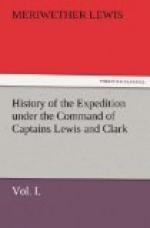of the same material about an ounce in weight, and
distributed over a small earthen platter, which is
laid on the fire for a few minutes, when they are
taken off to cool: with a little paddle or shovel
three or four inches long and sharpened at the end
of the handle, the wet pounded glass is placed in
the palm of the hand: the beads are made of an
oblong form wrapped in a cylindrical form round the
stick of clay which is laid crosswise over it, and
gently rolled backwards and forwards till it becomes
perfectly smooth. If it be desired to introduce
any other colour, the surface of the bead is perforated
with the pointed end of the paddle and the cavity
filled with pounded glass of that colour: the
sticks with the string of beads are then replaced on
their pedestals, and the platter deposited on burning
coals or hot embers: over the platter an earthern
pot containing about three gallons, with a mouth large
enough to cover the platter, is reversed, being completely
closed except a small aperture at the top, through
which are watched the bead: a quantity of old
dried wood formed into a sort of dough or paste is
placed round the pot so as almost to cover it, and
afterwards set on fire: the manufacturer then
looks through the small hole in the pot, till he sees
the beads assume a deep red colour, to which succeeds
a paler or whitish red, or they become pointed at
the upper extremity; on which the fire is removed
and the pot suffered to cool gradually: at length
it is removed, the beads taken out, the clay in the
hollow of them picked out with an awl or needle, and
it is then fit for use. The beads thus formed
are in great demand among the Indians, and used as
pendants to their ears and hair, and are sometimes
worn round the neck.
Sunday 17. A windy but clear and pleasant day,
the river rising a little and open in several places.
Our Minnetaree interpreter Chaboneau, whom we intended
taking with us to the Pacific, had some days ago been
worked upon by the British traders, and appeared unwilling
to accompany us, except on certain terms; such as
his not being subject to our orders, and do duty,
or to return whenever he chose. As we saw clearly
the source of his hesitation, and knew that it was
intended as an obstacle to our views, we told him
that the terms were inadmissible, and that we could
dispense with his services: he had accordingly
left us with some displeasure. Since then he
had made an advance towards joining us, which we showed
no anxiety to meet; but this morning he sent an apology
for his improper conduct, and agreed to go with us
and perform the same duties as the rest of the corps;
we therefore took him again into our service.
Monday 18. The weather was cold and cloudy, the
wind from the north. We were engaged in packing
up the goods into eight divisions, so as to preserve
a portion of each in case of accident. We hear
that the Sioux have lately attacked a party of Assiniboins
and Knistenaux, near the Assiniboin river, and killed
fifty of them.




